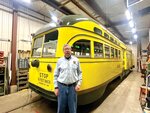
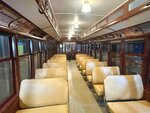
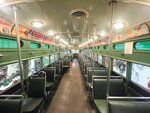


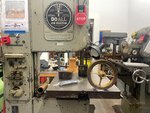
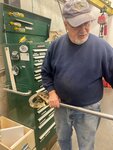
The Minnesota Streetcar Museum’s fleet of historic streetcars returned to the rails in Linden Hills last month, giving people of all ages the chance to ride on a little piece of Minneapolis history.
The streetcars run along the what was Como-Harriet Streetcar Line, which took passengers all the way from Linden Hills to downtown St. Paul. Today, though, the streetcars only make a one-mile journey back and forth between Lake Harriet and Bde Maka Ska.
This season, the museum is hosting a number of special events, from free rides for moms on Mother’s Day to Memorial Day rides to Lakewood Cemetery to a murder mystery-themed ride later in the summer.
For the first time this year, the museum will also host a pair of rides with American Sign Language interpreters onboard for hearing-impaired passengers. It will continue to offer several sensory-friendly events for neurodiverse individuals, as it has done for several seasons now.
“The idea is to make it accessible to an audience that ordinarily wouldn’t be able to get it all,” said Aaron Issacs, Minnesota Streetcar Museum Board chairman. He’s been a part of the museum since it started operating in Linden Hills in the 1970s; his dad, George K. Issacs was one of the founders.
The streetcars are especially popular among children, an age group that tends to be particularly obsessed with planes, trains, and automobiles.
“They think [the streetcar] is a train,” said Bill Arends, the Linden Hills stationmaster. “They say, ‘‘Let’s go ride the choo-choo.’ Well, an electric streetcar does not go ‘choo-choo,’ but it runs on rails so to kids, it’s a train.”
That’s a boon for business, too. While the Minnesota Streetcar Museum gets funding from donations, member dues, grants, and merchandise sales, their main source of revenue remains fares. It costs $3 a ride, more for some of the special events.
“If it’s big and mechanical and moves, they’re crazy for it,” Issacs said. “We get all of these little kids dragging their parents down over and over.”
The museum hosts weeklong summer camps each year to teach children about the history of streetcars in Minnesota and hopefully get them excited about preserving these historic artifacts for future generations.
Keeping these streetcars running year after year is no small feat. The entire museum is volunteer-runfrom the streetcar operators to the crews that maintain the buildings, grounds, overhead wire, and track.
The streetcars themselves need a lot of maintenance. The museum has two streetcars currently in operation on the Como-Harriet Streetcar Line, each representing a different era in Minneapolis’s public transportation history. Twin Cities Line streetcar No. 1300, built in 1908, is the oldest of the pair, while the other, No. 322, was built in 1946. It ran on the rails until streetcar service in the Twin Cities ended in 1954.
“This is machinery that had a finite life, a 30 to 40-year lifespan,” Issacs said. “Well, here we are running it 100 years after it was built.”
Every Tuesday and Saturday, a small but dedicated group of volunteers gathers in the car barn, a garage tucked away beneath the bridge at the intersection of Queen Avenue S. and Linden Hills Blvd. Here, they perform the necessary repairs on the streetcars, including replacing worn-out parts.
It’s not as easy as going to the store and buying a new one, though. These streetcars are old, and many of the parts aren’t interchangeable because they were made to fit that particular streetcar. That means volunteers like Dennis Stephens and Jim Willmore have to design and make the parts themselves, right in the car barn workshop, relying on old drawings from the museum’s library and vintage parts as a reference.
The museum counts many retirees among its members, but even they were only children when the streetcars stopped running. So, how do they know how to do all this?
“We don’t,” Stephens laughed. “A lot of us, we’re pretty much self-taught. We watch a lot of YouTube videos.”
The museum also relies on around 100 volunteers to work as streetcar operators, also known as motormen. It can take up to two months of training to learn how to drive one of these streetcars, and it’s much more difficult than it looks.
Just ask Jerry Betz. He started volunteering as a motorman last summer after his wife saw an article about the museum in another local paper and encouraged him to get involved.
“It’s not as straightforward as a gas pedal and a steering wheel on a car,” Betz said. “I said, ‘Oh, it rides on rails so you don’t really have to worry about steering, but it’s stopping on target and stopping smoothly [that’s the challenge].”
Some volunteers, like Ben Franske, started out riding the streetcars as a young kid. Now 40, he has been volunteering at the museum as both a motorman and the museum’s technology manager since moving back to Minneapolis years ago.
“Being a college professor, I have summers off. So I can drive [the streetcars] a lot. The first couple of years I was here I would be down three or four times a week driving. If you do that, they start giving you more things to do,” he said.
When the pandemic put a brief pause on the streetcar rides,it prompted the Minnesota Streetcar Museum to finally lean into technology, including digitizing its library and starting a YouTube channel where people can watch videos about how streetcars work and see some of the behind-the-scenes restoration work.
Issacs said they’re continually trying to expand the reach of the museum and educate more people about the days when people got around Minneapolis by electric trolley.
“We get people all the time that are like, ‘Oh, I didn’t know this was here.’ We get that a lot,” he said.
Comments
No comments on this item Please log in to comment by clicking here